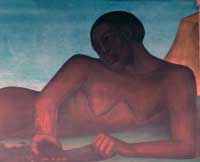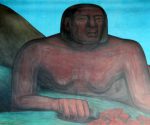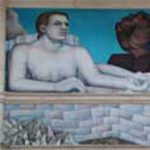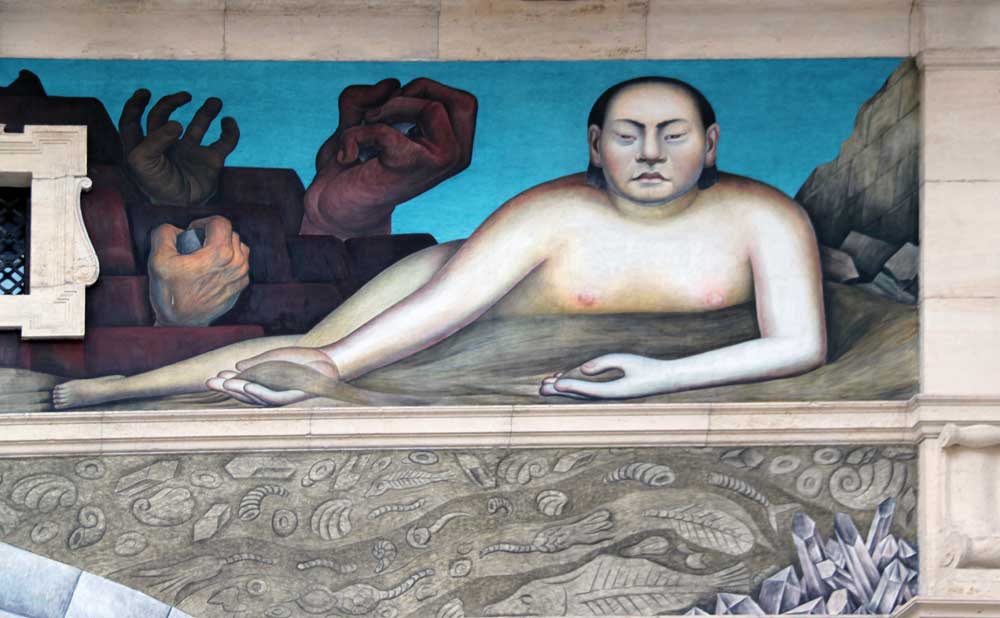a literary journal published by the Black Earth Institute dedicated to re-forging the links between art and spirit, earth and society
[Different kinds of stories (Editor’s Note)
Rusted blast furnaces, houses falling in, wages gone, alcohol up and now vegetables showing in previously scary lots, these are the usual stories. Millions of lives cannot escape these shadows of collapse but have yet another tale. Lives immersed in jobs and families.
Migration is for all of us. It’s beyond Irish digging canals, beyond Eastern Europeans coming to mills, beyond African-American sharecroppers coming to south side steel, beyond Latinos in kitchens and yet millions more than this come. Many stories are less iconic. Many are about coming from towns or cities that are not popularized in great migrations. Whether in life or locale we can start in one place and end up in another.
Stories of growth and impermanence in our lives hint at growth and impermanence in our cities, industries and even the land itself. Still in life and place the past can yet be present. Following are two essays, one a memoir of growing up away from the Rust Belt and reminding us of what is given and what is taken away. Biography is a reminder of the cycles in all things and here shows how distant small towns prepare us for life and loss yet brings us to another place. The second essay reminds us of the past in the present and even where we come from.]
IMPERMANENCE
My small hometown, Enid, Oklahoma, was thriving economically when I was born in 1964. Known at that time as the Wheat Capital of the World, grain elevators and oil rigs were my haphazard skyline in a vast vault of blue. Crops, cows and crude made the 1960’s and 1970’s vibrant for many in the Sooner State. However, a huge divide exists in Enid. An “other side of the tracks,” resides there, both literally and figuratively. Oklahoma remains a very conservative place, second now only to Arizona as the reddest state in the union. That said, my childhood was one of significant cultural diversity and an early awareness of difference.
I am the youngest of six children, and the second male child, of two working class parents, both now deceased. A four year span separates my birth and my next oldest sibling–I was not on my parent’s agenda. We lived in a crowded two-story A-frame on Cherokee Street. My brother had his own room and my two eldest sisters shared a room. I slept on the uncomfortable metal frames of two adjacent roll-away twin beds between my other two sisters for the first six years of my life. During the winter months those frames became unbearably cold. On occasion I sought warmth downstairs in my parent’s room, though it was not always welcoming.
As I revisit this memory, it occurs to me the tiny quarters I possessed early in life may have impacted my affinity for brevity in writing, and more. Acclaimed poet and mentor Afaa Michael Weaver, after critiquing a group of my poems, asked if I felt I didn’t have enough space. Generally I feel I don’t, though I am writing longer work.
Though I wanted for little as a child, a palpable unspoken tension lived in our home. As the youngest, I was the only one who did not hear or sense this ill regularly. My father, a consummate provider with a serious work ethic, disappeared every Friday evening and reappeared every Sunday evening smelling of alcohol and adventure. I was too young to fully comprehend why I spent weekend evenings alone. Then, in junior high and high school I began to piece things together, though still rarely discussed, and never in detail. My mama worked from 3:00 pm to 11:00 pm five days a week for 35 years, and two of those five were weekends. I spent a lot of time in books, in television, in my head.
 Of course my older siblings had to navigate the dysfunction in our house more directly and much more consistently. Their strength and perseverance is admirable—my two oldest sisters integrated the high school orchestra and the third oldest broke the drill team’s racial veil and led Black student walkouts in the early 1970’s—while enduring an unsettling undercurrent. Though it was ever-present, I actually witnessed only two moments that spoke to our sickness: dodging Daddy and my brother as they attempted to kill one another in the living room; and walking into that same room to see Daddy and Mama exchange blows to the face, and then wrestle. Both left scars. My brother left home the morning after that fight and I didn’t see him again for eight years. My three eldest sisters were off to college, and the sister just older than me was lost in her own world of popularity. She was a diva girl. Mama was either too ashamed to talk to me, or didn’t know how. My siblings forged armor to battle through and out the kingdom. I was left to interpret and filter. School was a refuge.
Of course my older siblings had to navigate the dysfunction in our house more directly and much more consistently. Their strength and perseverance is admirable—my two oldest sisters integrated the high school orchestra and the third oldest broke the drill team’s racial veil and led Black student walkouts in the early 1970’s—while enduring an unsettling undercurrent. Though it was ever-present, I actually witnessed only two moments that spoke to our sickness: dodging Daddy and my brother as they attempted to kill one another in the living room; and walking into that same room to see Daddy and Mama exchange blows to the face, and then wrestle. Both left scars. My brother left home the morning after that fight and I didn’t see him again for eight years. My three eldest sisters were off to college, and the sister just older than me was lost in her own world of popularity. She was a diva girl. Mama was either too ashamed to talk to me, or didn’t know how. My siblings forged armor to battle through and out the kingdom. I was left to interpret and filter. School was a refuge.
In 3rd grade, Zack, my best friend since Kindergarten and a full-blood Cherokee, and I were obsessed with the etymology of language, in addition to cars and basketball. Phonemic reading strategies still fresh from 1st Grade; we moved on to question the logic of words: Why is that thing called chair? Why is that a sofa? Growing up in a house filled with my sibling’s music while learning to read, I was already fascinated with sound and symbol. And Zack, as were most of my friends, was deeply immersed in imaginative play. Some of them well into high school, which seemed odd at the time. There were few things for kids to do in Enid. Sports and drinking were popular activities.
In spring of the same year, Roosevelt Elementary School administrators decided it a good idea to hold a mock Land Run in celebration of the 1907 settling of the territory thereafter known as Oklahoma. We were instructed to dress as cowboys and cowgirls, complete with hats and boots, cover our wagons with poster board, and come prepared to stake our claim of the four block wide playground. I hated cowboy boots even then.
I stomped around in my father’s cowhide skin as a baby, but never owned a pair, never wanted them, certainly after meeting Zack. Not that I was politically correct at age 7, I just never felt comfortable in them. I didn’t like steak either.
The morning of the Run was Technicolor, a warm blue sky our canopy as the bells clanged go. My neck adorned with bandana, blue jeans and gym shoes temporarily clean, I dragged my wagon at a fierce clip, yet careful not to loose its contents. Lunch was to be eaten on our claim, so my black imitation Radio Flyer was filled. I would not go hungry on my first day as a property owner. I waited until the bell sounded. I was no outlaw Sooner. Zack was close by, I thought, but don’t remember where. In hindsight I think of how twisted this activity might have been for him, and other Native students.
go. My neck adorned with bandana, blue jeans and gym shoes temporarily clean, I dragged my wagon at a fierce clip, yet careful not to loose its contents. Lunch was to be eaten on our claim, so my black imitation Radio Flyer was filled. I would not go hungry on my first day as a property owner. I waited until the bell sounded. I was no outlaw Sooner. Zack was close by, I thought, but don’t remember where. In hindsight I think of how twisted this activity might have been for him, and other Native students.
Zack was a fast runner. He and his cousin John perhaps the most athletic kids in my grade. But I don’t recall knowing where he was during the Run. Maybe they didn’t participate. Maybe they didn’t come to school that day. What I remember is laughing as I pulled that wagon, yelling at Chuck, one of my smart White friends, to get off my land. I’d pulled the plastic stakes and string from my wagon, the toy rifle too. I was king of my little turf. I opened up the pork & beans and smiled.
A few years later five of the more advanced 5th grade students were selected to study with the 6th graders for the entire school year. Chuck and I were among them. Zack and my other friends were left to endure the ordeal known as, no lie, Mrs. Haight. She was evil as Ms. Wheeler, so we were told. Now a newlywed, we learned marriage had not softened her. But there were too many of us and only one 5th grade teacher.
Our lunch times were different, but Zack and I hung out after school for a while. That summer Roosevelt was closed due to desegregation. We were placed in different 6th grade rooms in our new school, situated next door to the Junior High that represented our future. I reconnected with a kid I’d met on a basketball team in 3rd grade. Zack and I lost our grip. By 9th grade we were distant relatives. Though my home life was a mess I had yet to discover booze and drugs. Zack was way ahead of me. A roach clip hanging from his flowing Black mane well before I knew what marijuana meant.
The dude, with whom I reconnected on the basketball court, as well as our 6th grade teacher, changed my life. Russell L. Hutchison and I recognized one another as soon as I stepped in Mrs. Kay Everly’s classroom. We became inseparable, class clowns competing for the highest G.P.A., Mrs. Everly our firm but nurturing guide. She was a joyous woman and a fine teacher who retained her fascination with learning. She even laughed when Russ and I created a chalk dust cloud at the back of the room. Then she changed our seat assignments. She left prior to the close of the school year to give birth. We were devastated to the point I have no memory of her replacement. I corresponded with Mrs. Everly when I was an undergraduate at the University of Oklahoma (OU). Her image warms my spirit.
In Russ I found a lover of words, music and sports again. We survived junior high, both of us naïve and girl-clumsy. Russ found his footing with women in high school almost immediately. I remained awkward with girls romantically, but served as his Cyrano de Bergerac and biggest fan. I realize now my first persona poems were written in Russ’s voice. We had a pretty high success rate.
Our junior year of high school we enrolled in Introduction to Journalism. Both Russ and I wrote for the school newspaper in junior high, in addition to acting in plays and serving as student council officers. In fact our announcements, which we wrote in promotion of various activities, made us legends at Longfellow Jr. High for many years. Funny how reliving these memories sews a seam I’ve failed to acknowledge.
We both tested for spots on the high school newspaper staff for our senior year. Russ earned the second highest score and mine was somewhere in the middle. We claimed two of the 24 staff positions and the grand opportunity to further our studies with one of the greatest educators I have ever known. Mrs. Cynthia Rae Dougherty was into cats (Kliban and real), social justice, and laughter. In her spare time she taught us what it meant to be a journalist and work as a team. She sponsored staff softball and basketball teams, and nurtured me into an award-winning high school sports columnist. She also unofficially directed the political campaigns of two best friends and me as we ran for Student Council president, treasurer, and vice-president, respectably. We all won, the “Fun Boy Three” (borrowed from the band formed by three former members of British Ska band “The Specials”) campaign a smashing success, and Enid High had its first Black student council officer in several years.
 Mrs. Dougherty’s affect on me was so profound I knew my professional life would center on language and communication, though the mediums changed twice. I enrolled at OU as a print journalism major in 1982, then switched to Radio/TV/Film (Broadcast Journalism) my sophomore year. It was during this year I met Dr. William McKeen, journalism professor and creative non-fiction author. He validated my questions, my search for identity, my anger and my eclectic taste in music. He helped initiate my search for self. Nationally recognized for his biographies on outlaw journalist Hunter S. Thompson, McKeen himself is brilliant rebel and accomplished rabble-rouser.
Mrs. Dougherty’s affect on me was so profound I knew my professional life would center on language and communication, though the mediums changed twice. I enrolled at OU as a print journalism major in 1982, then switched to Radio/TV/Film (Broadcast Journalism) my sophomore year. It was during this year I met Dr. William McKeen, journalism professor and creative non-fiction author. He validated my questions, my search for identity, my anger and my eclectic taste in music. He helped initiate my search for self. Nationally recognized for his biographies on outlaw journalist Hunter S. Thompson, McKeen himself is brilliant rebel and accomplished rabble-rouser.
I close with a love song for my best friend Russ, nine years young as an ancestor, and perhaps my greatest teacher.
We had a few rough moments, but for the better part of 27 years, Russ was as necessary as food. The youngest of three, and the only male child, Russ was courtesy and thoughtfulness to my extrovert and charisma. His older sisters were peace-loving hippies and my siblings were Black Power people. We were made for one another. Russ was perhaps the most kind, balanced, conscientious human I have ever known. His was the voice of reason to my spitfire. Russ was always in pursuit of growing, of being better to the world. Not a day transpires that I don’t think of him. His jarring, tragic hiking death in 2001 was the second in a series of profound losses in my life in the span of six years: Ms. Brooks; Russ; a cousin; my parents; a close aunt; and our other closest Oklahomey, Michael Tod Lilburn. I attempt recovery every single day. A great rift in my family manifested when my mama died, so I lost most of my mother’s people as well. I lost my birthplace. I am transient. This is now where I live.
MISPLACED
On January 19, 2005, my mother, Dorene Myles, joined the ancestors, quite unexpectedly, from complications due to misdiagnosis. One of her doctors prescribed a sulphur-based medication to address the closing of her lungs. My mother was allergic to sulphur. While standing at her bedside with a circle of relatives, I found myself touching the papyrus her skin had become as she took her last breath, repeating the words “Thank you,” as I felt her leave the room.
By the time I went to the lobby area, the fight was already in progress. Two of my sisters were engaged in very public disagreement about a variety of topics: whether to sue the doctor for malpractice; when to have the funeral; whom had taken better care of Mama, and my father, who had also recently died; who was the better daughter. The lines were clear, and two of my aunties, one of whom is the pastor of the church in which my entire family was reared, and their children, chose the sister and the side that my other siblings and I opposed.
That side made every decision regarding my mother’s home-going unbearable and hate-filled, including holding a dinner at one of their homes and not the home of the deceased. But when my pastor auntie hung up on me as I delicately explained our desire for a closed casket ceremony, the deep hurt informed me I had just suffered more loss. She directed venomous, coded prayers toward us at church the day before the funeral, and at the service itself. We barely looked at one another.
In February of 2006, I was invited to join a team of scholars from Chicago State University to work with educators in Ghana to develop textbooks for primary school students in math, environmental studies, and reading/literacy. We were to develop these materials in English, with more indigenous art, culturally sensitive illustrations, and with a “girl-forward” focus, as the drop out rate for teenage girls in Ghana is almost 80%, particularly in rural areas. This was to be my first trip to Africa, and the nation Nkrumah built had always been one of my two top choices. A long held dream coming to fruition.
While standing in line for our connecting flight to Accra at Amsterdam’s Schipol Airport, fatigued and excited, I noticed a woman walking our way whom looked familiar. As she approached, I thought “What is Charolette doing here?” Charolette, meaning Dr. Charolette Myles-Nixon, my second oldest sister, on whose side I resided. “She’s supposed to be in Turkey.” As the woman drew nearer, I rejoiced in the hue of her skin, the dense Africa of her body, her wide dark eyes. She might have thought I was stalking her. This woman was Charolette. I don’t mean my actual sister was there, but my actual sister was there. Same skin tone, same body features, same face, same mannerisms. I was looking directly at lineage, 400 years removed.
The following afternoon a colleague and I took advantage of the only day off we would have for a week to explore Accra. We took a taxi from our hotel on the Atlantic to downtown, known as Accra Center. Think Manhattan with twice as many people and two stoplights. Plus, a brother can get a cab. After reaching a point where it no longer made good sense or good time to ride, we hopped out and hit the chaotic streets. I am not certain why we were immediately recognizable as African Americans. I do not know if it was our clothes, or our beards, or something about how we moved through the world, some ill-begotten swagger. Is this African retention idea reversible? We were identified quickly, and welcomed with same vigor.
We rounded a cacophonous corner that opened into a round-a-bout with six options. No one was going anywhere, and the moist air stung of car horns and fish. As we passed a group of elder merchants sitting on the sidewalk, my eyes wandered across the street. There, behind countless red and blue bags of countless things, in dizzying sunlight, stood my pastor auntie and her three children. I stopped in my tracks and watched them watch me. I walked closer to the curb for a better look. How could it be? Why, of all people, would these folks, whom had inflicted so much torture on me regarding what was already the most difficult moment in my life, be the Igbo or Fulani family staring at me from across the way?
Upon returning to the States, a poet friend said I saw that auntie in Ghana because I needed to forgive her. I am not there quite yet, though I did see her recently, at a funeral, and we finally shared words. None about my mother.

Author Biography
Quraysh Ali Lansana is author of five poetry books, including They Shall Run: Harriet Tubman Poems (Third World Press, 2004); a children’s book titled The Big World (Addison-Wesley, 1998); and editor of eight anthologies, including Dream of A Word: The Tia Chucha Press Poetry Anthology (Tia Chucha Press, 2006). He is Associate Professor of English/Creative Writing at Chicago State University, where he served as Director of the Gwendolyn Brooks Center for Black Literature and Creative Writing from 2002-2011. He is a former faculty member of the Drama Division of The Juilliard School and former Associate Editor-Poetry for Black Issues Book Review. Quraysh earned a Masters of Fine Arts degree at the Creative Writing Program at New York University, where he was a Departmental Fellow. Our Difficult Sunlight: A Guide to Poetry, Literacy & Social Justice in Classroom & Community (with Georgia A. Popoff) was published in March 2011 by Teachers & Writers Collaborative and was a 2012 NAACP Image Award nominee. mystic turf, his third full-length book of poetry, will be released in November 2012 by Willow Books.
©2025 Black Earth Institute. All rights reserved. | ISSN# 2327-784X | Site Admin